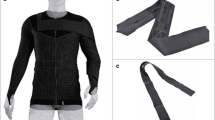Abstract
The objective of this study was to determine the direction of the migration engendered by the middle deltoideus on the upper end of the humerus. Eleven patients suffering from shoulder pathology underwent an MRI examination (3 mm thick slices). From these MRI slices, 3D reconstructions were obtained for each patient by using a manual data capture system (SliceOmatic®). From this geometry, a mechanical model of the deltoideus was produced, taking into account the contacts between the latter and the following anatomical parts: supraspinatus, infraspinatus and humeral head. For the 11 shoulders, we have obtained a deltoideus showing a global resultant oriented upwards. There was, however, a component oriented downwards (at the level of the humeral head), its intensity being 40–80% less than the component oriented upwards (at the level of the deltoideus V). It is important to note that this study is valid only in the initial degrees of lateral elevation. The deltoideus is an elevator muscle of the humeral head in the glenoid, presenting nevertheless a component oriented downwards. The deltoideus would, therefore, intervene to recenter the shoulder during an abduction movement.




Similar content being viewed by others
References
Browning DG, Desai MM (2004) Rotator cuff injuries and treatment. Prim Care 31(4):807–829
Castaing J, Burdin Ph (1979) Anatomie fonctionnelle de l’appareil locomoteur: Le complexe de l’épaule fascicule 1. Editions Vigot, Paris, pp 22–26
De Palma AF, Callery G, Bennett GA (1949) Shoulder joint: variational anatomy an degenerative lesions of the shoulder joint. In: Blount WP, Banks SW (eds) Américan Academy of Orthopédic Surgery instructional courses lectures, vol 6. JW Edwards, Ann Arbor, pp 255–281
Duchenne de Boulogne GB (1867) Physiologie des mouvements. JB Baillière et Fils, Paris, pp 53–72
Ferrari F, Governi S, Burresi F, Vigni F, Stefani P (2001) Supraspinatus tendon tears: comparison of US and MR arthrography with surgical correlation. Eur Radiol 12:1211–1217
Gagey O, Hue E (2000) Mechanics of the deltoideus: a new approach. Clin Orthop 375:250–257
Inman VT, Saunders M, Abbot LC (1944) Observations on the function of the shoulder joint. J Bone Joint Surg 26A:1–30
Inui H, Sugamoto K, Miyamoto T, Machida A, Hashimoto J, Nobuhara K (2001) Evaluation of three-dimensional glénoid structure using MRI. J Anat 199:323–328
Kapandji IA (1987) Physiologie Articulaire, vol 1. Maloine SA, Paris, pp 44–72
Revel M, Armor P, Copail R, Anctil R (1984) Etude électrokinésiologique du sous scapulaire, du grand pectoral et du grand dorsal au cours de l’abduction. In: Simon L, Rodineau J (eds) Epaule et médecine de rééducation. Masson, Paris, pp 333–338
Sarrafian SK (1983) Gross and functional anatomy of the shoulder. Clin Orthop Relat Res 173:11–19
Togami I, Sasai N, Tsunoda M, Sei T, Yabuki T, Kitagawa T, Mitani M, Akaki S, Kuroda M, Hiraki Y (2001) Kinematic magnetic resonance imaging (MRI) of the normal shoulder: assessment of the shapes and signals of the supérior and inférior labra with abductive movement using an open-type imager. Acta Med Okayama 55(4):237–243
Acknowledgements
We greatly appreciate the support of D. Jauffret and S. Chanson, student engineers at ENSAM, Paris (France), for their participation in the development of the mechanical model.
Author information
Authors and Affiliations
Corresponding author
Rights and permissions
About this article
Cite this article
Billuart, F., Gagey, O., Skalli, W. et al. Biomechanics of the deltoideus. Surg Radiol Anat 28, 76–81 (2006). https://doi.org/10.1007/s00276-005-0058-8
Received:
Accepted:
Published:
Issue Date:
DOI: https://doi.org/10.1007/s00276-005-0058-8




